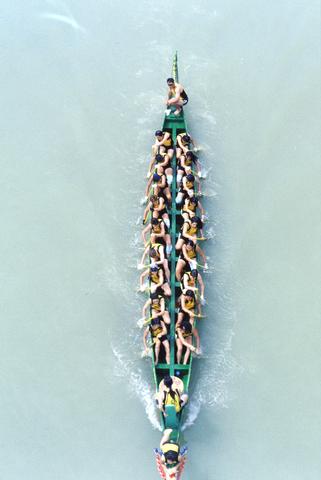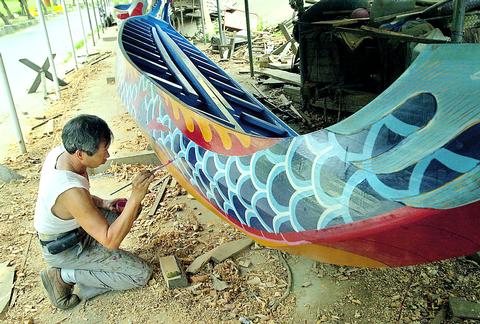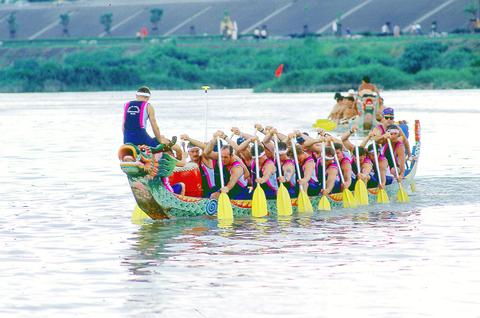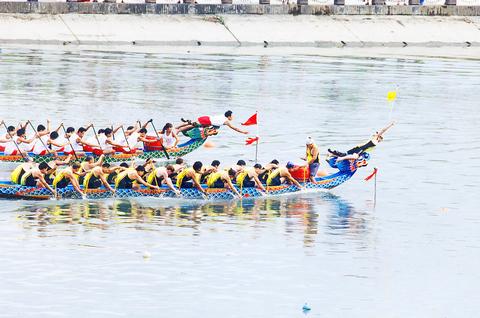There are few sports that are more essentially Chinese than dragon boat racing, and with the Tuanwu Festival (
The eye-dotting ceremony for the boats taking part in this race will be held this afternoon between 1pm and 3 pm, at the Tachia section of the Keelung River beneath the Tachih Bridge.
Chang Chin-jen (

PHOTO: LYNN LEE
The Hsintien team has an advantage over other local teams, for as the managing body for a dragon boat racing area at Bitan (
Bitan is the venue of the Taipei County Congressional Cup Dragon Boat Races (台北縣議長盃龍舟錦標賽), which are held a week before the Taipei City event. The boats used in the Taipei County races are much more modern, being made of fiberglass. The Taipei City race uses traditional wooden boats that are heavier and wider.
Joining the lineup

PHOTO: AP
The Taipei International Dragon Boat Race Championships have only been held on the Keelung River -- specifically, the Tachia section (大佳段) beneath the Tachih Bridge (大直橋) -- since 1995, when the Taipei City Government began co-sponsoring the races with the Taipei Municipal Sports Federation. That year, the city government completed a major reconstruction project to straighten out the Keelung River and establish a park on its banks.
So far, the international division in the 2001 competition has nine registered men's teams and three women's teams, including teams from Hawaii, the Philippines, Canada, Thailand, and Japan. A few teams, however, are guaranteed participants in the event.
One such team is the Aqua Fortis Dragon Boat Rowing Team from the Philippines. "We have been participating in the Taipei dragon boat races since 1993," states Earnest S. Versoza, the drummer and over-all leader of the Philippine delegation. "We were overwhelmed by the warm acceptance of the Taiwanese when we came the first time, and we have participated ever since."

PHOTO COURTESY OF HUANG CHUNG-HSIN
Two other teams with assured positions in the lineup are locally-based teams consisting of foreign students studying at Chinese language schools: the Taipei Language Institute (TLI) and the Center for Chinese Language and Culture (CCLC), formerly the Mandarin Training Center. Both schools have fielded teams in the Taipei City races for at least twenty years.
Janie Moor from England, who is serving as captain of the TLI team for her second year and participating for her third, attributes her continued participation to the wonderful feeling that she gets when building up the team.
"It's a great feeling when you have a group of people who do not really know each other that well, but who must work together to get the boat moving; and once everyone begins to fall in sync with one another, it's especially exciting, because the boat surges forward almost like a rollercoaster ride. It's very exhilarating!"

PHOTO COURTESY OF YEH MING-YUAN
Tsuyoshi Kano from Japan, a member of the CCLC team who has been participating for three years now, gives three reasons for rejoining: "First, it's a great place to meet a lot of new friends. Second, the cultural aspects and traditions behind the races are so deep and meaningful, and it's great to be a small part of that. Finally, the overall experience and the feeling of accomplishment when it's done -- it's a great memory to take back to Japan of my stay here in Taiwan."
Ancient traditions
The Dragon Boat Festival occurs on the fifth day of the fifth lunar month -- which falls on June 25 this year -- and is filled with many ancient customs and rituals.
Dragon boats are a very important feature of the festival and were originally used as part of an elaborate ceremony for supplicating the water gods to prevent floods and other natural disasters. Later, they also became associated with the death of the poet Chu Yuan (屈原) in 290BC, who drowned himself in the Milo River of Hunan Province (湖南省). The beating of drums and splashing of oars which are so much part of dragon boat racing were originally intended to scare away fish who might desecrate the poet's body.
Tradition dictates that before a dragon boat can be used in a race, the eyes on the dragon's head adorning the prow of every boat must first be opened. This is done several weeks before the race itself in a special ceremony.
The ceremony to open the eyes of the dragon is presided over by a Taoist priest. Ringing a bell and burning incense, he first blesses the boats, and then race officials daub a bit of red paint onto each dragon's eyes to "open" them. This is followed by lion dances and other performances as the dragon boats are carried to the river by the various teams. The boats are paddled up and down the racecourse as fire crackers, sticky rice cakes and ghost money are thrown into the water, in part as offerings to the River God, in part to commemorate the spirit of Chu Yuan.
The eye-dotting ceremony for the Taipei International Dragon Boat Race Championships will be held today between 1pm and 3 pm, at the Tachia section of the Keelung River beneath the Tachih Bridge. Traditionally, the mayor of Taipei presides over the ceremony, and everyone is invited to come down and join the fun.
The Taipei International Dragon Boat Race Championships will be held on the three-day weekend of the festival itself, June 23-25. During the festival, aside from the races, which will take place between 8am and 5pm every day, the Taipei City Government will be organizing numerous other activities for spectators, such as kungfu and taichi performances, lion dances and folk art and handicraft exhibitions.
Dragon boat races in major cities and counties
For more information about the Taipei City races, check the offical bilingual Chinese-English Web site for this year's competition at http://dragon2001.nihs.tp.edu.tw
Chiayi County
Date: June 25
Contact: (05) 362-0123
Changhua County Date: June 23-25 Contact: (04) 722-2151 ext. 1051 or (04) 777-2668 Hsinchu City Date: June 25 Contact: (03) 521-6121 Ilan County Date (local): June 24-25 Date (national*): June 30, July Contact: (03) 936-4567 ext. 1440/1 *Note: Ilan County will be hosting the island-wide provincial dragon boat races this year. Kaohsiung City Date: June 23-25 Contact: (07) 723-2751 ext. 83 Kaohsiung County Date: June 23-25 Contact: (07) 747-7611 Keelung City Date: June 24-25 Contact: (02) 2420-1122 ext. 360 Miaoli County Date:June 24-25 Contact: (037) 322-150 Pingtung County Date: June 24-25 Contact: (08) 732-0415 Taoyuan County Date: June 24-25 Contact: (03) 479-3070 Tainan City Date: June 24-25 Contact: (06) 299-1111 ext. 1705 Tainan County Date: June 16-17 Contact: (06) 632-2231 Taipei City Date: June 23-25 Contact: (02) 2570-2330 ext. 120 Taipei County Date: June 16-17 Contact: (02) 2960-3456 Taitung County Date: June 22-23 Contact: (089) 326-141

The canonical shot of an East Asian city is a night skyline studded with towering apartment and office buildings, bright with neon and plastic signage, a landscape of energy and modernity. Another classic image is the same city seen from above, in which identical apartment towers march across the city, spilling out over nearby geography, like stylized soldiers colonizing new territory in a board game. Densely populated dynamic conurbations of money, technological innovation and convenience, it is hard to see the cities of East Asia as what they truly are: necropolises. Why is this? The East Asian development model, with

Desperate dads meet in car parks to exchange packets; exhausted parents slip it into their kids’ drinks; families wait months for prescriptions buy it “off label.” But is it worth the risk? “The first time I gave him a gummy, I thought, ‘Oh my God, have I killed him?’ He just passed out in front of the TV. That never happens.” Jen remembers giving her son, David, six, melatonin to help him sleep. She got them from a friend, a pediatrician who gave them to her own child. “It was sort of hilarious. She had half a tub of gummies,

The wide-screen spectacle of Formula One gets a gleaming, rip-roaring workout in Joseph Kosinski’s F1, a fine-tuned machine of a movie that, in its most riveting racing scenes, approaches a kind of high-speed splendor. Kosinski, who last endeavored to put moviegoers in the seat of a fighter jet in Top Gun: Maverick, has moved to the open cockpits of Formula One with much the same affection, if not outright need, for speed. A lot of the same team is back. Jerry Bruckheimer produces. Ehren Kruger, a co-writer on Maverick, takes sole credit here. Hans Zimmer, a co-composer previously, supplies the thumping

There is an old British curse, “may you live in interesting times,” passed off as ancient Chinese wisdom to make it sound more exotic and profound. We are living in interesting times. From US President Donald Trump’s decision on American tariffs, to how the recalls will play out, to uncertainty about how events are evolving in China, we can do nothing more than wait with bated breath. At the cusp of potentially momentous change, it is a good time to take stock of the current state of Taiwan’s political parties. As things stand, all three major parties are struggling. For our examination of the